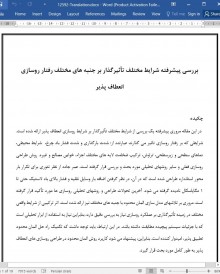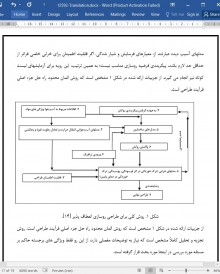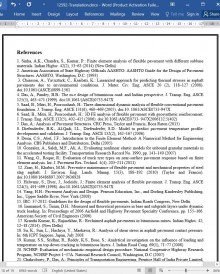
دانلود مقاله بررسی پیشرفته شرایط مختلف تأثیرگذار بر جنبه های مختلف رفتار روسازی انعطاف پذیر
چکیده
در این مقاله مروری پیشرفته یک بررسی از شرایط مختلف تأثیرگذار بر شرایط روسازی انعطاف پذیر ارائه شده است. شرایطی که بر رفتار روسازی تاثیر می گذارند عبارتند از: شدت بارگذاری و شدت فشار باد چرخ، شرایط محیطی، دماهای سطحی و زیرسطحی، تراوش، ترکیب ضخامت لایه های مختلف اجزاء، خواص مصالح و غیره. روش طراحی روسازی فعلی و سایر روشهای تحلیلی مورد بحث و بررسی قرار گرفته است. عمر جاده از نظر تئوری برای تکرار بار محور استاندارد طراحی شده است که در آن، در نظر گرفتن اضافه بار وسایل نقلیه و فشار بالای باد لاستیک حتی تا 1 مگاپاسکال نادیده گرفته می شود. آخرین تحولات طراحی و روشهای تحلیلی روسازی ها مورد تأکید قرار گرفته است. مروری بر تلاشهای مدل سازی المان محدود با جنبه های مختلف نیز ارائه شده است. اثر ترکیبی از شرایط واقعی مختلف در زمینه تأثیرگذاری بر عملکرد روسازی نیاز به بررسی دقیق دارد، بنابراین نیاز به استفاده از ابزار تحلیلی است که با جزئیات سیستم پیچیده مطابقت داشته باشد. در این ارتباط، باید توجه داشت که تکنیک راه حل المان محدود تطبیق پذیر، امیدوار کننده است. بنابراین، پیشنهاد می شود کاربرد روش المان محدود در طراحی روسازی های انعطاف پذیر به طور کامل مورد بحث قرار گیرد.
1. مقدمه
استفاده مستقیم یا غیرمستقیم از رابطه تجربی، اساس روشهای طراحی فعلی روسازی است که مبتنی بر تجربه طولانی مدت و آزمایشات میدانی مانند آزمون راه آآشو (اداره راهداران آمریکا) می باشد [27، 34]. طراحی روسازی خوب، یکی از مواردی است که عملکرد مورد انتظار را با سنجش اقتصادی مناسبی فراهم می کند. خصوصیات مصالح از لایه های مختلف روسازی و بارگذاری ترافیک، ورودی های اصلی مدل مکانیکی هستند. این رویکردها دقت قابل قبولی برای اهداف طراحی در سالهای اولیه دقیق دارند اما این سناریو به دلیل تغییر سریع بار محور و پیکربندی آن – که در هنگام طراحی روسازی های انعطاف پذیر باید برای بدترین تأثیر، مد نظر قرار داده شود – در حال تغییر است. مطالعات بیشتری باید انجام شود تا آثار مضر خستگی و شیارشدگی یافت شود؛ این آثار مضر به علت اثر ترکیبی پارامترهای مختلف محیطی (همچون تراوش، دما، و غیره) و بارگذاری اضافه ناشی از فشار زیاد لاستیک ها، ایجاد می گردند. روسازی های انعطاف پذیر تحت شرایط مختلفی قرار می گیرند که بر پاسخ روسازی تأثیرگذار هستند، اما ساخت ترکیبی از پارامترهای فوق در یک زمینه امکان پذیر و حتی عملی نیست. بنابراین ما باید مدلی را توسعه دهیم که یک سیستم چند وجهی را در بر می گیرد و شامل ویژگی های شرایط مختلف محیطی است. FEM یک ابزار چند زمینه ای است که می تواند اثر ترکیبی پارامترهای فوق را تحلیل یا ارزیابی کند؛ اینکار برای پیش بینی جنبه های رفتاری روسازی های انعطاف پذیر مفید خواهد بود. افزایش روزافزون وسایل نقلیه تجاری به همراه کامیون هایی بسیار سنگین که با بیش از دو برابر ظرفیت خود بار می زنند و همچنین تغییر در عوامل محیطی، از عوامل کاهش عمر روسازی جاده ها هستند [26]. در مقاله حاضر بهبودهای مختلفی در روشهای طراحی و کاربرد آنها در شرایط امروز به تفصیل بحث شده است.
4. روش معرفی شده برای تجزیه و تحلیل المان محدود
مشاهدات انتخاب شده از مطالعه نوشتاری برای تجزیه و تحلیل شامل رفتار ویسکوالاستیک لایه قیر، غیرخطی بودن در لایه های اساس دانه در نظر گرفته خواهد شد. در ابتدا، پیشنهاد شده است که تجزیه و تحلیل المان محدود دو بعدی دقیق از پارامترهای انتخاب شده برای تجزیه و تحلیل با استفاده از نرم افزار چند منظوره ANSYS انجام شود. علاوه بر این، تجزیه و تحلیل سه بعدی در حوزه شناسایی شده مورد سودمندتر از تجزیه و تحلیل دو بعدی برای پیش بینی دقیق تر نتایج انجام خواهد شد. در تجزیه و تحلیل المان محدود، یک زنجیره به المان محدود گسسته می شود، که در آن خصوصیات مصالح و روابط حاکم بر اساس مقادیر ناشناخته در گوشه ها اعمال و بیان می شوند. مجموعه معادلات با در نظر گرفتن زنجیره فوق با بارگذاری و محدودیت های مناسب شکل می گیرند. یک راه حل برگرفته از این معادلات، رفتار تقریبی زنجیره در نظر گرفته شده برای تجزیه و تحلیل را نشان میدهد [9، 38]. شکل 1 یک روش کلی اتخاذ شده برای طراحی روسازی انعطاف پذیر را نشان می دهد. پیکربندی روسازی شامل تعداد لایه ها، ضخامت هر لایه و نوع مصالح از کد عملی موجود لیست بندی می شود. ویژگی های اصلی مصالح مورد نیاز برای مدل های ساختاری ضرایب BL، لایه اساس (بستر) و زیرسازی است؛ مدل های آسیب دیدگی شامل معیارهای مختلف شکست هستند. در مدل های ساختاری/مدل های المان محدود، استفاده از شدت بار، شعاع تماس و تنش تماس از ورودی های ترافیکی و تعداد تکرارها توسط مدلهای خرابی (پریشانی) مورد استفاده قرار می گیرند. پاسخ روسازی شامل تنش ها، کرنش ها و خیز است. اینها از مدلهای ساختاری ارزیابی شده و به عنوان ورودی برای مدلهای خرابی استفاده می شوند. مدلهای آسیب دیده عبارتند از: معیارهای فرسایش و شیار شدگی. اگر قابلیت اطمینان برای خرابی خاصی فراتر از حداقل حد لازم باشد، پیکربندی فرضیه روسازی مناسب نیست؛ به همین ترتیب، این رویه برای آزمایشهای لیست کوتاه نیز انجام می گیرد. از جزییات ارائه شده در شکل 1 مشخص است که روش المان محدود راه حل جزء اصلی فرآیند طراحی است.
از جزییات ارائه شده در شکل 1 مشخص است که روش المان محدود راه حل جزء اصلی فرآیند طراحی است. روش تجزیه و تحلیل کاملاً مشخص است که نیاز به توضیحات مفصلی دارد، از این رو فقط ویژگی های برجسته حاکم بر مسئله مورد بررسی در اینجا مورد بحث قرار گرفته است.
Abstract
The paper provides a state-of-the-art review of different conditions influencing the behavioral aspects of flexible pavement. The conditions which influence the pavement behavior are loading intensities and tyre pressure intensity, environmental conditions, surface and subsurface temperature, seepage, thickness combinations of different component layers, material properties, etc. Current pavement design and analytical procedures are discussed and questioned. The life of the road is theoretically designed for repetition of standard axle load, wherein, negligence in consideration of overloaded vehicles and high tyre inflation pressures even up to 1 MPa is noticed. The latest developments in the design and analytical procedures of pavements are highlighted. An overview of finite element modeling efforts involving different aspects is also presented. A combined effect of various actual conditions in the field affecting the pavement performance needs to be studied in details, therefore, there is a demand for an application of analytical tool which can accommodate the details of the complex system. In this connection, it should be noted that the versatile finite element solution technique holds a bright promise. Therefore, it is proposed to discuss at length the application of the finite element method towards the design of the flexible pavements.
1 Introduction
Direct or indirect application of empirical relationship is the backbone of current pavement design procedures which are based on long-term experience and field tests such as AASHO Road Test [27, 34]. A good pavement design is one that provides the expected performance with appropriate economic consideration. The material characterisation of different pavement layers and traffic loading are the primary inputs into the mechanistic model. These approaches are reasonably accurate for design purposes in early years but the scenario has been changing due to rapid change in axle load and its configuration which has to be considered for its worst effect while designing flexible pavements. The enhanced study is necessary to find fatigue and rutting distress developed in different layers of flexible pavements due to the combined effect of different environmental parameters (like seepage, temperature etc.) and overloading with inflated tire pressure. Flexible pavements are subjected to various conditions which affect the pavement response, but it is practically not possible and even feasible to make a combination of all above parameters in a field, which creates a need to develop a model which considers a multifaceted system comprising of characteristics of the various environmental condition. FEM is a multidisciplinary tool which can analyze or evaluate the combined effect of above parameters which will be helpful to predict the behavioral aspects of flexible pavement. Day by day increasing the flow of commercial vehicles along with excessively loaded trucks beyond double its capacity and changes in environmental factors has been responsible for reducing the life of pavement [26]. In the present paper various improvements in the design procedures and its application to the present day condition are discussed in details.
4 Projected Methodology for Finite Element Analysis
The selected observations from the literature study will be considered for analysis including the viscoelastic behavior of bituminous layer, nonlinearity in granular base layers. Initially, it is proposed to carry the rigorous two-dimensional finite element analysis of the parameters selected for analysis using a multipurpose software ANSYS. Further, the three-dimensional analysis will be carried on the identified area of more interest from the two-dimensional analysis for more accurate prediction of results. In finite element analysis, a continuum is discretized into finite elements, over which the material properties and governing relationships are applied and expressed in terms of unknown values at corners. Set of equations is formed by considering the above continuum with appropriate loading and constraints. A solution of these equations gives the approximate behavior of the continuum considered for analysis [9, 38]. Figure 1 shows a general methodology adopted for flexible pavement design. The pavement configuration including the number of layers, the thickness of each layer, and the type of material are shortlisted from the available code of practice. The basic material properties required for the structural models are the moduli of BL, base layer and subgrade; those for the distress models involve the various failure criteria. In structural models/finite element models, the use of load intensities, contact radius and contact pressure from the traffic inputs and the number of repetitions is used by distress models. Pavement response includes stresses, strains, and deflection. Those are evaluated from the structural models and are used as inputs for distress models. The distress models include fatigue and rutting criteria. If reliability for a certain distress is beyond the minimum level required, the assumed pavement configuration is unsuitable; likewise, for all shortlisted trials, the procedure is implemented. It is apparent from details presented in Fig. 1 that the finite element method of solution constitutes a primary component of the design process.
It is apparent from details presented in Fig. 1 that the finite element method of solution constitutes a primary component of the design process. The method of analysis is too well known to need any more detailed description, hence only the salient features governing the problem under consideration are discussed herein.
چکیده
1. مقدمه
2. مروری بر مقالات پیشین
3. مشاهدات و پیشنهاداتی برای تحقیقات آینده
4. روش معرفی شده برای تجزیه و تحلیل المان محدود
منابع
Abstract
1 Introduction
2 Literature Review
3 Observations and Future Research Direction
4 Projected Methodology for Finite Element Analysis
References
- اصل مقاله انگلیسی با فرمت ورد (word) با قابلیت ویرایش
- ترجمه فارسی مقاله با فرمت ورد (word) با قابلیت ویرایش، بدون آرم سایت ای ترجمه
- ترجمه فارسی مقاله با فرمت pdf، بدون آرم سایت ای ترجمه



